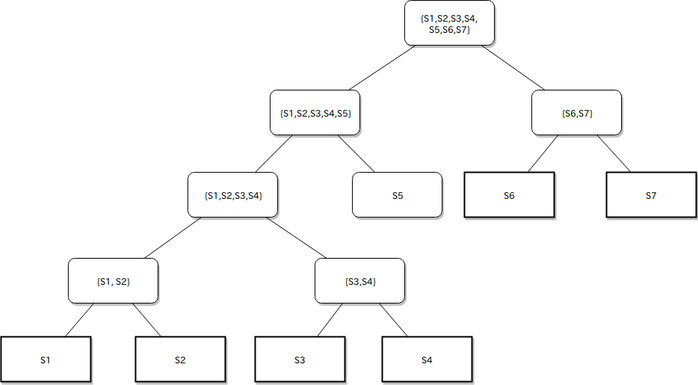This document describes how to we plan to upgrade from the Rchain State Proposal to a sharded version. The word name group and shard are used interchangeably.
CURRENTLY UPDATING PLEASE DO NOT READ
Shard Hierarchy
The shard hierarchy forms a tree. Shards at the leaves are identified with a single string and shards at the nodes are identified with sets of strings (representing the union of the children leaf shard identifiers). The root of the tree represents the "root shard", the shard that is identified by the union of all leaf shards. To support sharding, we add an additional shard annotation to Rholang. The syntax will be name: (Type/Sort, [Shard ID 1, Shard ID 2, ..., Shard ID N]), and only channel types can have shard annotations. When you annotate a name N with a shard identifier N_S, any name P with shard identifier P_S that is waiting for the name N as part of its input arguments or mentions N in its body/continuation must have an identifier that contains all elements of the shard identifier N_S, i.e., n ⊆ P_S for all n in N_S. Names that are not annotated with a shard identifier are assumed to have the same shard identifier as the name of the enclosing "for","!", or "contract". If the "for" is a join, then the shard identifier is automatically the union of the names that constitute the join. The name of a top-level "for","!", or "contract" automatically has the shard identifier at the level it was deployed. To prevent too many shards from being generated, a new shard ID can only be generated by declaring a new shard name when deploying, i.e., Deploy(<code>, shard: "0xuniqueshardID").
Examples
The following is a deployment that generates a new shard S1 and stores contract@"Bar" as its first waiting continuation.
Deploy(
contract @"Bar"(...) {
new Foo {
...
}
},
shard: "0xS1"
)
The following valid deployment will be parred into the top level of shard S1.
Deploy(
contract @"Bar"(...) {
new Foo {
contract Foo(baz: (Ch[Int], ["0xS1"])) {...} |
Foo!(...)
}
},
shard: "0xS1"
)
The following deployment is invalid as @"Bar" needs to be deployed to a shard with an identifier that contains at least ["0xS1","0xS2"].
Deploy(
contract @"Bar"(...) {
new Foo {
contract Foo(baz: (Ch[Int], ["0xS1","0xS2"])) {...} |
Foo!(...)
}
},
shard: "0xS1"
)
I've drawn a valid sharding hierarchy below - eventually I would like to write up Rholang code with a corresponding deployment order that would actually generate this.
Validator to Shard Hierarchy Mappings
Shards will be assigned a validator set through the Casper contract. The mapping must preserve three properties: 1) validators cannot guess the shard they are assigned to (preventing DOS attacks), 2) validators that are assigned to a leaf/node must also be assigned to every parent node (mitigating parent shard fork choice hijacking), and 3) "enough" validators/stake must be assigned to the shard. Nodes (as in computers, not tree nodes) can validate blocks without participating in consensus.
Validator Set to Shard Hierarchy Mapping Proposal 1
1) A contract deployer creates a new child shard by proposing a "merge block" that acts as the genesis block for that new child shard. It contains at minimum a new child casper contract along with a new state trie for that child shard. When you fork a new shard, the new shard's validators are initially the same as the parent.
Changes to the Structure of a Block
Sharding introduces "merge blocks", blocks that are validated across shards in the sharding hierarchy. Merge blocks can only occur along the branch lines of the sharding hierarchy. For example, from the above diagram, we can have a merge block between "S1" and "{S1,S2}"; "S2" and "{S1,S2}"; and "S1", "S2", and "{S1,S2}". But not "S1" and "S2". A "merge block" spans multiple shards and is part of the blockchain of all the constituent shards. Instead of a single state root, each merge block will have multiple state roots (and most importantly multiple Casper contract instances) - one for each shard it merges. Each Casper contract defines the master shard (set) of its children blocks. The master shard (set) chain must not contain cycles.
